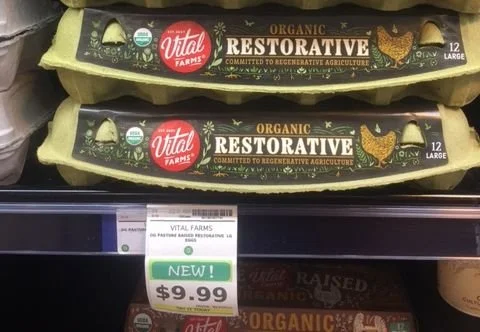Buzz Words
Oh no, not new buzz words, the marketing speak that drives farms nuts as we get caught having to explain the latest trendy schtick trying to capture the consumer’s attention and dollar. There have been two I’ve encountered over the last few weeks that I want to weigh in on this week in Dishing the Dirt.
I knew something was up when customers commented that eggs at the market were so cheap. Cheap? So I joked that that only the men I date get to call me cheap.
The egg farmers raised their prices this year after grumbling about the rising costs of feeds and fuel while also dealing with bird shortages due to the Avian Flu outbreak the previous year. As farmers, we work pretty darn hard to supply our customers with the best possible products while using environmentally friendly and socially responsible farming practices. We work with economies of scale within our communities selling directly to our customers. Yet we’re still constrained by legalese as to how we label our products. Unless we’re shelling out for a third-party oversight many of the high profile descriptions are off limits. There’s organic and then there’s Certified Organic. There’s grass-fed, grass finished and Certified Grassfed. How many people really understand the difference between humane and Animal Welfare Approved?
Needless to say, when I hit up my favorite co-op for things I can’t get at the market I was flabbergasted when I saw $9.99/dozen eggs. I was definitely a cheap date.
But what was restorative? That was a new one on me. Regenerative agriculture has been an up and coming term for sustainable farmers to differentiate themselves from conventional and commodity agriculture after NPR’s Market Place allowed Monsanto to usurp sustainable in return for their advertising dollars. Kai Ryssdal, I will never forgive you for that one.
Certified Organic became passé as consumers realized massive factory farms got to use the magic words on their labels as long as they followed protocols, kept the necessary paperwork, and paid the certification bodies. I’ve been listening to Rob at Young Harvests passionately explain why he’s not certified and his explanation always leaves me wanting to yell, PREACH from the other side of the isle.
All week I chewed on the idea of restorative agriculture. What is being restored? In my search for an answer the word soil kept popping up. Well, no kidding. Maybe if they’d been taking care of the soil in the first place consumers would have to pay them the extra few bucks regularly to restore what they should have been taking care of all along!
Which brings me to the second new buzz word—rewilding. One of those trendy hobby farm magazines must have had an article because in the last few weeks I’ve had several people ask me if I ever considered rewilding part of the farm. There are already bears, coyotes, porcupines, deer, raccoons, opossums, skunks, foxes, raptors, migratory songbirds, and water fowl. A few days ago on the way down to the barn in the morning I spied what I thought was a new barn cat I’d have to trap and neuter. Nope, it was a Bobcat and since that sighting I’ve heard it screaming throughout the neighborhood. I wonder if it’s feasting on the wild turkeys who’ve been strutting through the hayfields or if it will go for the easy pickings buffet of laying hens.
How much you want to bet that those folks writing and talking about rewilding don’t have to make a living from feeding others off what they grow on the land? I’m not talking only about protein production, but fruits and vegetables, too.
Regardless of what we’re growing, we’re constantly faced with challenges from nature. Some farmers choose to fight these challenges with the heavy hand of technology and others choose to let nature take it’s course, harvesting a modest bounty. The key is learning to live in the balance, in peace.
While marketing gurus and influencers tell consumers what restorative and rewilding mean, let me tell you what it means for a farmer. It means simple, common sense things like cultivating a few rows of highly attractive plants for pests away from the main crops, keeping hemostats handy for pully quills from the dog’s nose, and not killing off key species in the food web so nature decides to feast on what we grow. Every single thing we do has a cascading impact on our environment and our ability to successfully grow food.
New buzz words may catch the attention of concerned consumers, but what truly matters is actions that produce positive results. I’m going to create my own buzz word and start calling the difference between those premium priced buzzword bedecked products and the lesser priced items found at the market (which are ultimately fresher and better) the Good Farmer Discount. No coupon needed.

